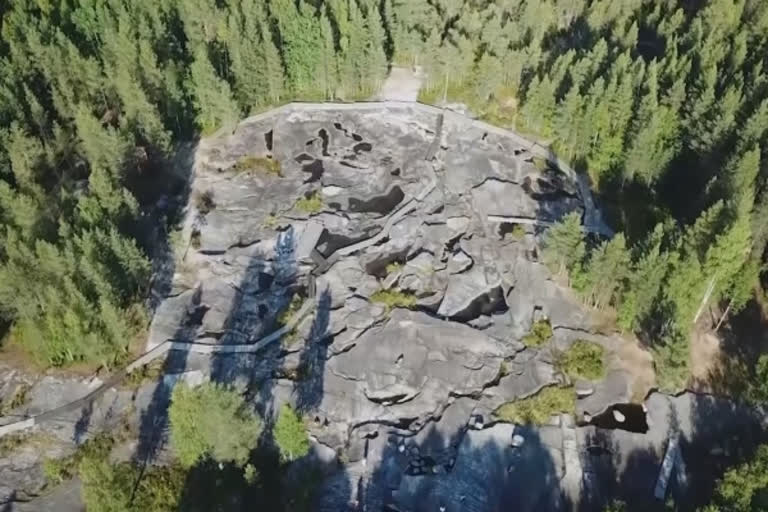Belomorsk (Russia): Discovered in 1926, a drawing of a huge moose etched into the rock just outside Belomorsk, north-west Russia. This is just one of thousands of ancient petroglyphs on this coast that could soon be awarded UNESCO World Heritage status. The artworks, depicting life in the Late Neolithic era, were originally created on seacoast rocks and offshore islands between 5-7 thousand years ago. Since then, the White Sea has receded 7 kilometres - exposing a watery art history museum of Neolithic rock art. 95 years ago, a young ethnographer Alexander Linevskiy was alerted to 'devil's trails' on a river rock by local villagers - the first three thousand petroglyphs were discovered with many more revealing themselves over the following decades. On the eastern shore of Lake Onega, more than 1,200 figures cover an area of 18.5 km.
At a second site 330km away, the Petroglyphs of the White Sea spread out 1.8 km from north to south and 0.6 km from west to east. There are at least 3,400 individual figures in 11 clusters. The largest petroglyph field, called Zalavruga, was found by accident in the 1960s after topsoil was removed for construction needs. "There are a lot of petroglyphs in the world. Technically, there are clusters bigger than ours quantitively and much more ancient – up to 40 thousand years old, but in terms of scenes, composition, movement, development, dynamics – it's like ancient comics, there is nothing like that anywhere on Earth," says Alexei Verbov, curator of Zalavruga petroglyph site. Most of the petroglyphs depict the daily life of the Neolithic people – hunting, fishing, and evidence of the use of skis.
READ: Palaeolithic site in Indian subcontinent spotted in Haryana
"Belugas, reindeer, moose, swans, large birds – all these allowed ancient humans to survive. It's the Neolithic epoch, Late Neolithic. These petroglyphs are estimated to be five-six thousand years old," says Tatiana Golovina, director of the Belomorsk Petroglyphs Museum. The etchings were made using jackhammers made from quartz - which is found here in abundance. Carving the artworks was hard and long. It took researchers recreating a petroglyph using the same tool about 30 minutes to etch a 10 cm line. It is believed that each cluster of petroglyphs had its own author, presumably a leader of hunters or fishermen or perhaps a shaman who was responsible for spiritual connections. Different groups were created over a vast period of time - the earliest rock paintings in Belomorsk are one thousand years older than the latest.
One petroglyph depicts 12 men chasing a beluga with a harpoon. Another, three skiers surrounding a moose with spears. Another shows a human-like creature with a horn at the back of his head, big feet, hands, and phallus. Scientists believe it to be a forest or sea spirit favouring lucky hunting or fishing, showing that the ancient people took part in ritual practice. It is thought that rock art was created as a kind of tutorial or message from the ancients to the next generations as they tried to share their knowledge and experience. "It is the most interesting geological place because the rocks date back three billion years. If Earth is 4.5 billion years old, outcropping (happened so early) that it's almost the origins of Earth, and we can touch them. It is the largest cluster of petroglyphs in Northern Europe, more than three thousand images," says Golovina.
READ: Row over dredging of ancient irrigation tank Sri Lanka by military camouflage-clad Chinese men
Lichen, precipitation, and the soles of visitors' shoes spell danger for these ancient petroglyphs. To preserve the oldest images in Belomorsk, Soviet authorities built a pavilion that covers the whole rock. It was renovated and reopened this summer. Both the Petroglyphs of Lake Onega and the Petroglyphs of the White Sea have been nominated for UNESCO World Heritage. They are believed to belong to the same period and culture although they differ in character.
The Lake Onega rock carvings feature many fantastical half-human half-animal creatures. Those of the White Sea are more mundane - hunters, gatherers, sea animals and birds. Locals believe that UNESCO recognition would revive the entire area - that suffered an economic decline after the turbulent 1990s in Russia. "It (recognition by UNESCO as World Heritage site) would be a breakthrough because (it would help to fulfil) the main mission, which is preservation. And, of course, popularisation is also very important, as the tourist site could be a significant starting point for the development of Belomorsk district and the whole Republic of Karelia. Practically, the birth of the new brand is happening before our eyes," says Golovina.
READ: Six Indian sites on UNESCO's world heritage list
Currently, around 10,000 people from other Russian regions and abroad visit the petroglyphs each year. Authorities hope that as a World Heritage Site, the Belomorsk Petroglyphs would attract at least three times that number. Plans are in place to build a tourist centre, hotels, and cafes due for completion in 2024. A new road leading to the Zalavruga petroglyph field is about to be finished. The decision on whether the petroglyphs are awarded World Heritage status will be made at the World Heritage Committee's 44th session, chaired from Fuzhou, China. Last year's annual meeting was postponed due to COVID-19, so this extended session will take place online from 16 to 31 July.
AP



